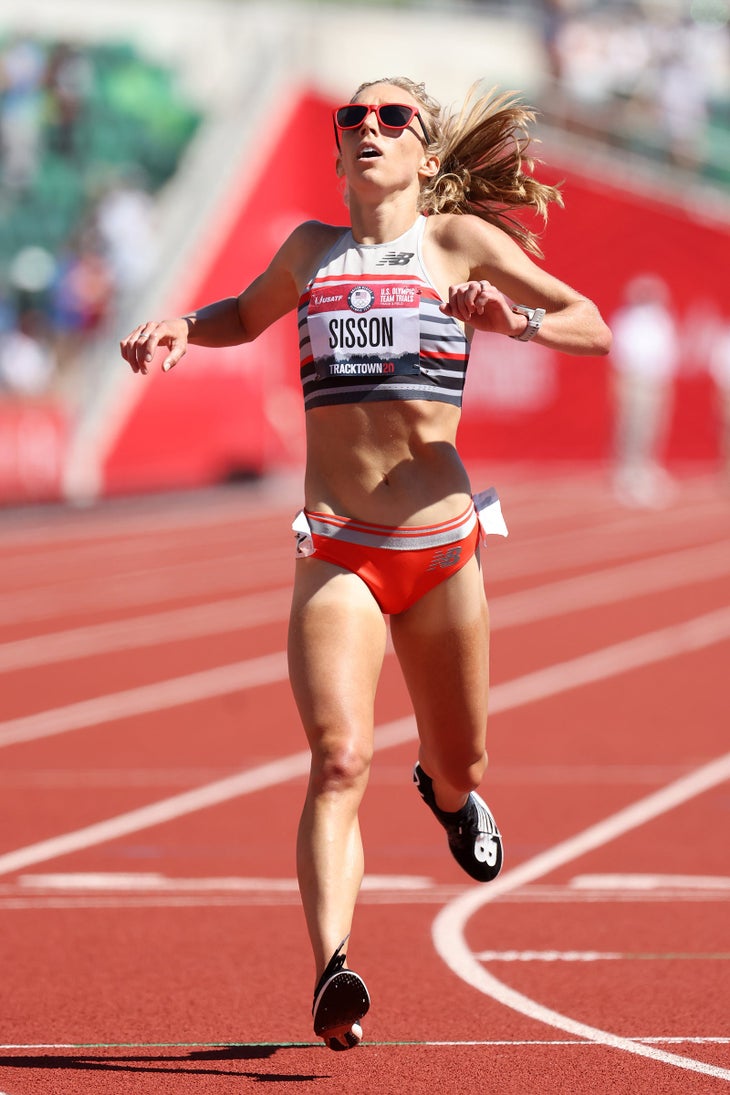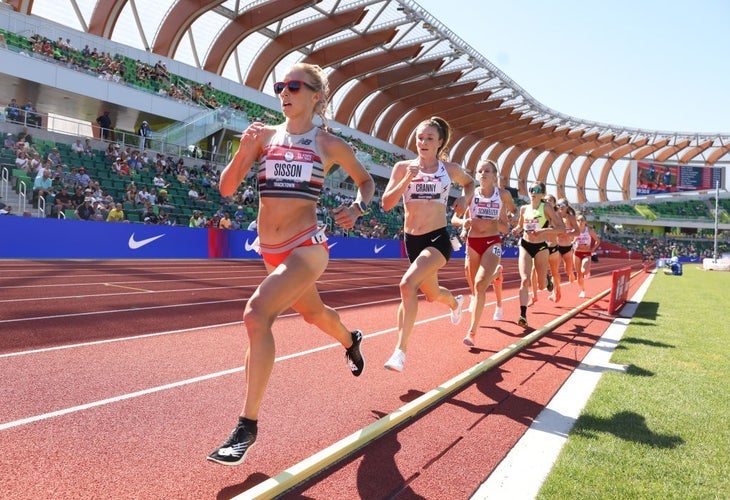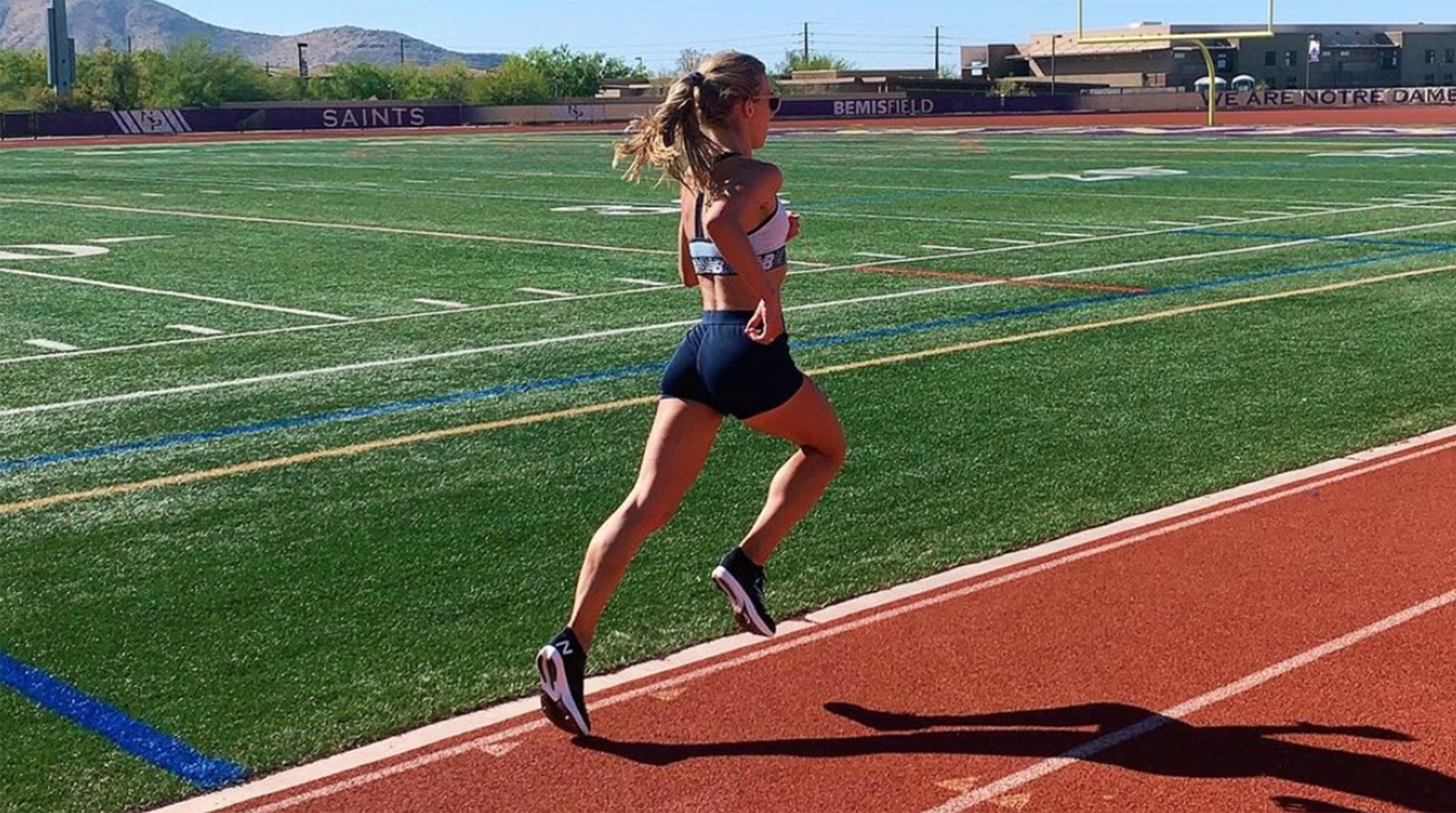It was sometime in May when Emily Sisson knew she was back. Her legs felt ŌĆ£bouncyŌĆØ again, she was hitting times in workouts that she never had before, and her confidence was soaring.
ŌĆ£I just felt like IŌĆÖd reached another fitness level,ŌĆØ she says.
Her long-time coach, Ray Treacy, knew it too: ŌĆ£She was at a completely different level than where she was ever before. We were quite confident she could lead the whole way, or most of the way at the Trials.ŌĆØ
And she did, taking control just after the mile and pushing the pace out front before dropping the hammer (and her pursuers) with 5 laps to go. From there, she ran to a commanding victory and an Olympic Trials record (31:03.82).

The win marked the end of a long comeback for Sisson. In February, 2020, she dropped out of the U.S. Olympic Marathon Trials in Atlanta ŌĆö a race that had been her long-term goal since she graduated in 2015 from Providence College, where she won two national titles in the 5,000m and set a national indoor record.
Sisson ran the 10,000m at the 2016 Olympic Trials, but had been injured during the year and placed 10th. ŌĆ£After that,ŌĆØ she said, ŌĆ£The goal was obviously: four years time, you want to be on that team.ŌĆØ
She and Treacy had always felt the marathon was where she would excel, and they set that as the goal for 2020. Her debut at the 2019 London Marathon in 2:23:01, the eighth-fastest American womanŌĆÖs time ever, seemed to prove them right. It certainly set her up as a favorite to make the U.S. marathon team, even to win the trials.
But SissonŌĆÖs dream was not to be realized on the windy hills in Atlanta. She dropped out at mile 22.
How did she get from a DNF to dominating the 10,000m in Eugene? She and Coach Treacy shared the journey and the strategy:
1) Do a Stride Reset
When COVID-19 stopped nearly everything right after the Marathon Trials, Sisson first took time to recover.
ŌĆ£I took three weeks off completely from running, my body really needed that after the trials,ŌĆØ she says. ŌĆ£Then, I took over two months of slowly building back up close to full mileage. I really took my time.ŌĆØ
Treacy is known for being conservative and careful in his coaching, and fully supported the break. ŌĆ£Coming out of Atlanta, she was beat up pretty good,ŌĆØ he says. ŌĆ£It took her a good while to get over the soreness and emotional side of not making the team. It took a while to get her feeling good again and running. We took a very slow approach to getting back to it.ŌĆØ
They didnŌĆÖt just recover, but used the extra time to evaluate and reset.
ŌĆ£One thing my chiropractor and coach both told me, you should use this time wisely,ŌĆØ Sisson says. ŌĆ£My chiropractor said, ŌĆśYouŌĆÖre never going to have a break like this, from training and racing, without being injured. So letŌĆÖs take this time to do a , work out kinks.ŌĆÖŌĆØ
The most significant kinks were revealed from a visual review of her running form during the Marathon Trials. ŌĆ£I noticed in pictures that my stride was different than before ŌĆö at the London Marathon and track races,ŌĆØ she says. ŌĆ£I looked like I was shuffling a bit more and didnŌĆÖt have the same hip extension.ŌĆØ
To get her stride back, she focussed on strengthening her posterior chain ŌĆö glutes and hamstrings ŌĆö her upper body posture, and her mobility, to allow her stride to flow backwards and not be as quad dominant. ŌĆ£I did a lot of hip hinging movements, bridges, core strength.ŌĆØ
One of her favorite exercises is what she calls the ŌĆ£Triple ThreatŌĆØ using a yoga ball. It involves two kinds of bridges and hamstring curls. ŌĆ£Basically working a lot of the posterior chain, trying to get that firing,ŌĆØ she says. ŌĆ£Not even for strength; reminding my hamstrings that they are there, they need to activate.ŌĆØ
ŌĆ£After all of that I felt like I was shuffling less, and I was getting ŌĆ£bouncyŌĆØ legs back,ŌĆØ she says.
But she didnŌĆÖt stop once things felt better. ŌĆ£I need to regularly keep doing stuff like that,ŌĆØ she says. Even a week before leaving for Tokyo sheŌĆÖs been doing her strength and mobility routines three times per week.
2) Keep Strengths Strong
ThereŌĆÖs a reason Sisson gravitated toward the marathon: her strength is her stamina. Even when transitioning her training toward the track and the shorter goal distance, she hasnŌĆÖt abandoned what makes her a great runner. She still puts in steady 90-100 mile weeks and maintains her key endurance runs.
ŌĆ£I still have my tempos and long runs,ŌĆØ she says. “Those are really important for me. IŌĆÖve learned if I stop doing those, I donŌĆÖt run as well. Even when IŌĆÖm track training I need .ŌĆØ
And long runs, too, though they take a less important role in the training rotation than during marathon training. When getting ready for the marathon, Sisson regularly logged 22ŌĆō24 long runs, sometimes quite hard. For track training, she limits her long runs to 16-18 miles, and keeps the pace easier. In other words, she goes shorter and slower.
ŌĆ£When IŌĆÖm marathon training, I like to do long run progressions,ŌĆØ she says. ŌĆ£When not marathon training I like them to be good, solid efforts, but wonŌĆÖt consider them a workout ŌĆö I wonŌĆÖt run them quite as hard.ŌĆØ
Similarly, her tempo runs are not as long.
ŌĆ£I do a lot of 2 x 4 mile tempos, and I do 7 mile tempos, occasionally 8. When IŌĆÖm marathon training I do a little longer,ŌĆØ Sisson says. ŌĆ£So the volume is less, but still decent. We try to make sure IŌĆÖm not neglecting those.ŌĆØ
3) Work the Speed
After resuming her training volume, Sisson first targeted the Valencia Half Marathon in early December, where she ran a PR 67:26, one second shy of the American record. Then she turned her full focus to the 10,000m.
The main shift in SissonŌĆÖs training was to spend more time on the track doing quicker workouts. She does strides several times a week, year round, and, of course, does track workouts. ŌĆ£When IŌĆÖm marathon training I still get on the track, because I think it actually is important,ŌĆØ she says. ŌĆ£But I probably only get on the track once every three workouts. Right now, for every three workouts, IŌĆÖm on the track twice, and that third oneŌĆÖs a tempo. So IŌĆÖm on the track a little bit more.ŌĆØ
Treacy believes in full recovery between workouts, so they donŌĆÖt cram them all into a week. They take three easy-to-moderate days between each hard workout, rotating through speedier track workouts (400m ŌĆō 1 K repeats), tempo runs, longer track workouts (2K to 1.5 mile repeats), and long runs. It ends up being a 10-day to 2 week cycle, depending on how much recovery is needed for the long run.
The increased emphasis on speed over the winter and into the spring paid off. ŌĆ£We knew the strength was there, from all the marathon training, and all the work IŌĆÖve put in,ŌĆØ Sisson says. ŌĆ£But the speed was coming around really nicely the last few months too.ŌĆØ
The ease and speed at which Sisson was running these workouts bred confidence, particularly when she started matching workouts of training partner Molly Huddle, who owns the American 10,000m record, set at the 2016 Olympics where Huddle placed 6th. ŌĆ£She was very, very comfortable with the 400s,ŌĆØ Treacy says. ŌĆ£To be able to do workouts similar to what Molly was doing at her best, going into the trials, gave her a lot of confidence.ŌĆØ
| Key workouts | SissonŌĆÖs Splits | Race Pace Equivalent |
|---|---|---|
| Pre Trials | ||
| 16 x 400m | 12 at 68-69, last 4 in 66, 64, 64, 63, with 75-second recovery | ~3K race pace down to mile race pace |
| 4 x 1.5 mile | 7:15 with 2:30 recovery | ~10K race pace |
| 9 x 1K | 2:55 with 2 minutes recovery | ~5K race pace |
| Since Trials | ||
| 2 x 4 miles | 5:12 pace with 2 minutes recovery | ~15K race pace |
| 7 x 800m + 4 x 400m | 800s in 2:20, 400s in 65ŌĆō66 | ~5K ŌĆō 3K race pace |
4) Roll Through the Taper
Sisson kept the rotation of workouts turning, and her volume of 90-100 mile weeks, up to two weeks before the trials, then she slightly reduced the stress. ŌĆ£We did a little bit less,ŌĆØ Treacy says. ŌĆ£Emily doesnŌĆÖt like doing that, just likes to keep training away. She gets sluggish if she backs off too much.ŌĆØ
Four days before the race they did her final workout, a countdown ladder:
2K / 1600m / 1200m / 800m / 400m
ŌĆ£That was just four days before the trials,ŌĆØ Treacy says ŌĆ£I wanted that to be more controlled as she was heading up to Eugene that evening so we kept it kind of low key: 6:10, 4:56; 3:36; 2:20 and I think she ran a 66 400 at the end of it. She could have gone again, doing the same if I wanted her to, but it was only four days before the trials.ŌĆØ
They had run similar ladders earlier during this 10K training cycle and they bolstered Sisson’s faith in her preparation: ŌĆ£At the end of that workout, when IŌĆÖm getting pretty tired, then weŌĆÖll throw in two 400s ŌĆö and that simulates when youŌĆÖre at the end of a race and you have to close hard the last 400. And doing all those workouts I was able to run faster 4ŌĆÖs than IŌĆÖve ever run, so that definitely gave me confidence.”
After that last ladder, Sisson truly tapered, running an easy eight miles the next day, then only 3ŌĆō4 mile shake outs in the two days prior to the race.
5) Plan and Practice
Come race day, she was ready, not just because of her training but because they had devised a plan and practiced it.┬Ā Sisson noted, “A lot of the girls I was racing, I know they have really good kicks, so that was something I was very aware of.ŌĆØ Plus two runners ŌĆö Elise Cranny and Karissa Schweizer ŌĆö┬Ā had snuck under SissonŌĆÖs PR in February (both ran 2 seconds faster than Sisson’s 30:49.57).
Treacy says they spent hours working on tactics for how Sisson could win the trials: ŌĆ£How was she going to beat two people who had run faster than her over 10K, and were probably faster than her over the last half?ŌĆØ
The plan they devised had two key elements: Sisson would run from the front the majority of the race, and she would kick from 2K out ŌĆö the last 5 laps. She practiced the latter of these tactics at the Sound Running Invite 5000m in early March, where she ran the last 5 laps in 5:49, closing with a 67.65 en route to a PR 14:55.82.
Two weeks later, at the Gate River Run 15K in Jacksonville, Florida, she practiced the second tactic: leading from the gun. ŌĆ£The goal there was to run from the front the whole way, to see how she would handle being out front for that amount of time,ŌĆØ Treacy says. ŌĆ£And that went well too.ŌĆØ
Sisson won Gate River by nearly a minute over Lindsay Flanagan, recording the fifth fastest time (48:09) in the eventŌĆÖs 44-year history.
Sisson says Treacy has been teaching her to how to lead a race since college, when he impressed on her that, ŌĆ£When youŌĆÖre running from the front, you canŌĆÖt be running scared.ŌĆØ And, she says, you do need to work on the skill. ŌĆ£It is hard, it takes practice,ŌĆØ Sisson says. ŌĆ£When youŌĆÖre leading from the front, you want to try to make it uncomfortable, but, at the same time ŌĆö since youŌĆÖre leading and doing the work ŌĆö you can’t be going all out. You need to be prepared, that if there are people at the end of the race still there, that you have another gear. You have to do your best to judge that effort youŌĆÖre giving to make sure you have enough left in the tank that you can respond.ŌĆØ
Sisson entered the trials practiced and positive, knowing what she could do. And Treacy says, ŌĆ£She executed the plan brilliantly.ŌĆØ

6) Embrace the Heat
Not only did Sisson triumph over the other runners in Eugene, but she seems to defy the oppressive heat, beating Deena KastorŌĆÖs 17-year-old Olympic trials record despite 85+┬░F temps that sent bronze-medalist Alicia Monson to the hospital post-race. Sisson says she has gotten lots of questions about how she prepared for the heat, and has to admit that she didnŌĆÖt do anything specific like wear extra clothing during training.
But she does live in Phoenix and has made her body and mind used to the . ŌĆ£I think the huge benefit I have, because I live in Phoenix, I kind of know what to expect,ŌĆØ she says. ŌĆ£I know how to prepare for those races: Things to do, things to avoid, and I also think I can gauge my effort level better. In the heat it can feel uncomfortable, and can feel uncomfortable early on ŌĆö you have to know where that line is. I donŌĆÖt always get it right; I have had workouts where I went a little too hard in the heat in the beginning and I was struggling a bit more. But I think that experience maybe helped me a bit. IŌĆÖve gotten a lot better, and I donŌĆÖt often blow up in a workout, it is pretty rare.ŌĆØ
Besides being able to judge her response to the heat accurately, SissonŌĆÖs training through Arizona summers has taught her to accept and endure this specific discomfort. In Eugene, she knew it was going to be hot, for her and her competitors. ŌĆ£Knowing it is hot for everyone, that is really important,ŌĆØ Sisson says. ŌĆ£I remember thinking in the race, if IŌĆÖm hot, everyoneŌĆÖs hot.ŌĆØ
In preparation for Tokyo, Sisson returned to Providence for her final weeks of training to get used to the humidity. ŌĆ£SheŌĆÖs pretty used to hot weather, she acclimatizes well,ŌĆØ Treacy says, but adds, ŌĆ£I donŌĆÖt know if anybody can be acclimatized to the weather theyŌĆÖre going to have in Tokyo, however. ItŌĆÖs so hot and humid. ItŌĆÖs a level above what weŌĆÖre used to.ŌĆØ
7) Stick to Strengths
Also a level above will be the competition in Tokyo. Sisson will face competitors who have run far faster than her, most notably the duo of Sifan Hassan and Letesenbet Gidey who traded the world record earlier this year, both running close to 29 minutes. ŌĆ£Yep. I know. ThatŌĆÖs so fast,ŌĆØ Sisson says.
But, while Treacy admits that it is going to be ŌĆ£a completely different ball game ŌĆö sheŌĆÖs not going to run away from everybody,ŌĆØ the numbers donŌĆÖt tell the whole story. For one, Treacy says, you have to take the trials race conditions into consideration. ŌĆ£SheŌĆÖs in really, really good shape,ŌĆØ Treacy says. ŌĆ£Given the weather and her leading pretty much the whole way, I would say she was definitely in 30-minute shape, for sure.ŌĆØ
Then thereŌĆÖs the way championship races play out. SissonŌĆÖs been watching how previous Olympics and World Champ races were run. “It seems like, historically, when it has been hot and humid, the races are not like a Rio, where they went off really fast,ŌĆØ Sisson says. ŌĆ£It seems like, when it is hot and humid, it is more tactical.ŌĆØ
Even if the runners bide their time, however, it wonŌĆÖt likely come down to the last lap. ŌĆ£It will be tactical to a point,ŌĆØ Treacy says, ŌĆ£And then the race will get going ŌĆö pretty early, I think, because no one wants to hang around for Hassan to out kick them. Certainly Gidey wonŌĆÖt want to hang around that long. So it is just a matter of being as comfortable as you can and being able to finish well over the second half.ŌĆØ
ThatŌĆÖs good news for Sisson, who, although sheŌĆÖs been working on her kick (recall those workout-closing 400s), believes her endurance will be as significant an asset in the Tokyo heat. ŌĆ£When it is hot and humid, it kind of feels like a longer race than 10K,ŌĆØ she says. ŌĆ£ThatŌĆÖs what we said at the Trials: itŌĆÖs going to feel like a 7 or 8 mile race, because it is so hot. So thatŌĆÖs why I think the endurance is really key.ŌĆØ
Treacy agrees, and says, regarding EmilyŌĆÖs kick: ŌĆ£You can only do what you can do. You have to keep working to your strength. Emily is only going to get as fast as she can in the last 400. SheŌĆÖs not going to win a lot of races in the last 400 ŌĆö certainly at that level. So we have to keep working on her strength, and thatŌĆÖs being able to run hard the last 2 to 3 K of the race. In these kind of conditions, the race will stretch out anyway. They wonŌĆÖt want to have 8 of them together at the bell waiting for a big kick. I donŌĆÖt think it is going to be that kind of a race ŌĆö it will stretch out at some stage, and when that happens youŌĆÖve got to be able to keep a good pace all the way to the finish.ŌĆØ
And then, hopefully, pick people off in the closing laps and finish on the podium.
ŌĆ£That would happily be the plan,ŌĆØ Treacy says.
—
before watching her run on .


